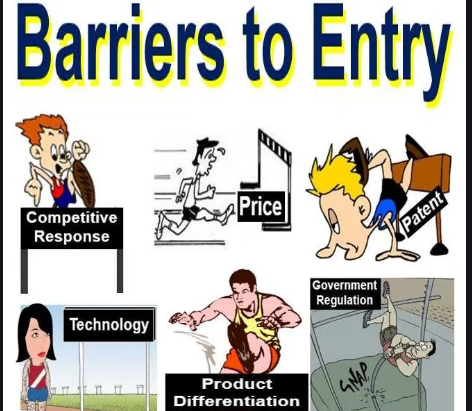Ever heard of barriers to entry and actually wondered what it means? Here is your answer.
What is Barriers to Entry?
Barriers to entry as the name implies, are obstacles or hindrances which make it difficult for new companies to penetrate a given market. These barriers range from things like technology challenges, government regulations, patents, start-up costs, or education and licensing requirements.
How Barriers to Entry Works
Some barriers to entry are a result of government intervention, while others, on the other hand, come about naturally within a free market. Most times, firms are known to lobby for the government to create new barriers to entry, in a bid to protect the integrity of the industry as well as prevent new entrants from introducing inferior products into the marketplace.
On the whole, firms favor barriers to entry when already comfortably grounded in an industry in order to limit competition and claim a larger market share. Other barriers to entry occur naturally and often evolves over time as certain industry players establish dominance. Barriers to entry come in two main categories known as the natural and artificial barriers to entry.
Types of Barriers to Entry
There are two categories of barriers, which are the natural (structural) barriers to entry and artificial (strategic) barriers to entry.
Artificial (Strategic) Barriers to Entry
Predatory pricing, and an acquisition: This is where a firm may deliberately lower prices in order to force rivals out of the market. Firms as well may take over a potential rival by purchasing sufficient shares in a bid to gain a controlling interest.
Limit pricing:This is when existing firms set a low price and a high output in order to stop potential entrants from making a profit at that price.
Advertising:Also seen as a sunken cost, this implies that the higher the amount spent by incumbent firms, the greater the deterrent to new entrants.
Brand:A firm with strong brand value, creates loyalty of customers, and hence, discourages new firms.
Contracts, patents, and licenses:This makes it difficult for new firms to penetrate the market when the existing firms own the license or patent.
Loyalty schemes:With special schemes and services, oligopolists can retain customer loyalty and discourage new entrants who wish to gain market share.
Switching costs:This applies to costs that are incurred by a customer in the process of trying to switch suppliers. It covers the cost of purchasing or installing new equipment, loss of service during the period of change, the efforts involved in searching for a new supplier or learning a new system. These costs are exploited by suppliers to a large extent in a bid to discourage potential entrants.
Natural (Structural) Barriers to Entry
Economics of scale:Here, new entrants will be discouraged if a market has significant economies of scale which have already been exploited by the existing firms to a large extent.
Network effect:This term refers to the effect that multiple users have on the value of a product or service to other users. If there is already a strong network on the ground, it might limit the chances of new entrants to gain a sufficient number of users.
High research and development costs:This happens when firms spend huge amounts on research and development. It is most times a signal to the new entrants that they have large financial reserves. To compete, new entrants would also have to match or exceed this level of spending.
High set-up costs:Most of these costs are sunk costs which cannot be recovered when a firm leaves a market like advertising and marketing costs as well as other fixed costs.
Ownership of key resources or raw material:This is having control over scarce resources, which other firms could have utilized, which creates a very strong barrier to entry.
Sources of Barriers to Entry
Barriers to entry stem from seven sources:
- Economics of scale: This is the decline in the cost of operations because of the higher production volume.
- Product differentiation: This is the brand strength of the product as a result of effective communication of its benefits to the target market.
- Capital requirements: These are financial resources that are needed for operating the business.
- Switching costs: A one-time costs the buyer must incur because of making the switch to a different product.
- Access to distribution channel: Are they all controlled by one business, or are they open?.
- Government policy: These are controls that the government has placed on the market, like licensing requirements.
- Cost disadvantages independent of scale: When a company has advantages that can’t be replicated by the competition, like proprietary technology.


